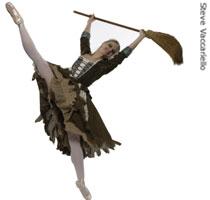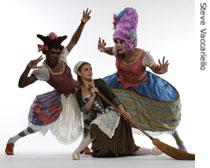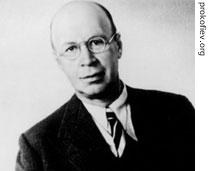-
(单词翻译:双击或拖选)
Sergei Prokofiev’s ballet version of “Cinderella” is a favorite with choreographers and dance lovers. Transcript2 of radio broadcast:
03 June 2008
VOICE ONE:
I’m Steve Ember.
VOICE TWO:
 |
| The Washington Ballet’s Brianne Bland3 as Cinderella |
And I’m Shirley Griffith with EXPLORATIONS in VOA Special English. Today we explore the ballet version of one of the most popular stories ever told. Throughout history, in cultures around the world, the story of Cinderella has remained a favorite. We tell about the music Russian composer Sergei Prokofiev wrote for his version of “Cinderella.”
And, we visit the artistic4 director of the Washington Ballet as he and his dancers work together to perform this famous ballet.
(MUSIC)
VOICE ONE:
Her name may be Yeh-shen, Cendrillion or Aschenputtel. But her story is always about a caring young woman who overcomes her difficult family life with the support of a magical helper. This helper makes the dreams of Cinderella come true. And, by the end of the story Cinderella is repaid5 for her goodness when she marries the man she loves.
One of the earliest versions of the story comes from ninth century China. Yeh-shen talks to a magic fish, which makes her wishes come true. The Algonquin Native American version is about Rough-Face Girl, whose kindness and inner beauty win the love of an invisible warrior6 spirit.
VOICE TWO:
The seventeenth century French writer Charles Perrault included another version in his book, “Tales of Mother Goose.” His version is one of the most famous. Cinderella lives with her father's second wife and the woman's daughters.
 |
| Cinderella and her stepsisters, performed by Aaron Jackson and John Goding |
Cinderella's stepmother and stepsisters are unkind to her and make her do all the work in the house while they prepare for a party given by the ruling prince.
Cinderella’s fairy godmother gives her beautiful clothes to wear to the party. She magically turns a pumpkin7 and mice into a carriage pulled by horses so Cinderella can go to the party. But, the godmother warns Cinderella that she must return home by midnight, when all of her magical belongings8 will turn back into their normal forms. After the party, Cinderella hurries home but leaves her shoe behind. This glass slipper9 helps the prince search for and find Cinderella so that they can marry and live together happily ever after.
VOICE ONE:
The story of Cinderella has influenced many creators of books, movies, songs, and dances. One of these was Russian composer Sergei Prokofiev. In nineteen forty, he began working on a new musical version of the ballet. But he did not finish the ballet until nineteen forty-four because he took time to write his opera “War and Peace.” During these years, Europe was torn apart by World War Two. Some of this tension can be heard in the music Prokofiev wrote for "Cinderella." Some of the music is very light and beautiful, but at other times it is quite dark and tense.
VOICE TWO:
 |
| Sergei Prokofiev |
Prokofiev’s “Cinderella” was first performed at the Bolshoi Ballet in Moscow in nineteen forty-five. Prokofiev’s musical score does not say exactly what must happen in the story. But it does make musical suggestions. For example, in an early scene, the stepsisters receive much needed dancing lessons before the party.
(MUSIC)
While the scene where Cinderella and the prince dance together is a gentle musical expression of love.
(MUSIC)
There is also a clear moment in the score when Cinderella realizes it is time for her to return home from the party.
(MUSIC)
And, Prokofiev also created musical moments for dances influenced by other cultures. For example, when the prince searches for Cinderella, he travels to a land influenced by Spanish music.
(MUSIC)
VOICE ONE:
The music permits choreographers to use their imaginations to create dances for new versions of the story. For example, in the nineteen eighties, French choreographer1 Maguy Marin created a “Cinderella” for the Lyons Opera Ballet. In it, the characters are all toys living in a doll house. The dancers wear face coverings and padding to look like dolls. For the party scene, they come together to play children’s games like jumping rope.
In nineteen eighty-six, Russian dancer Rudolf Nureyev’s "Cinderella" was performed at the Paris Opera Ballet in France. This story was set in the nineteen thirties. Cinderella dreams of becoming an actress. Her magical supporter is a movie producer who introduces Cinderella to her prince, a famous actor.
In the nineteen nineties, choreographer Matthew Bourne set his “Cinderella” during the bomb attacks that hit London, England during World War Two. The prince character is a pilot who meets Cinderella when he is wounded and stays for a short time in her family’s home. After he meets Cinderella, he must search for her in the war-torn city streets.
(MUSIC)
VOICE TWO:
Last month, the Washington Ballet performed “Cinderella” at the Warner Theater in Washington, D.C. We wanted to understand how a choreographer creates the dance steps for such a large production. So we talked to Septime Webre, the artistic director of the Washington Ballet. We asked him why he chose to perform this ballet this year. The Washington Ballet last performed Cinderella in two thousand three.
(MUSIC)
SEPTIME WEBRE: "Prokofiev’s score is one of the great scores written for ballet, and one of the two probably most important ballet scores written in the twentieth century along with Prokofiev’s "Romeo and Juliet." I set the repertoire11, and so I wanted every season there to be a narrative12 arc10, a kind of journey for the audience, from beginning to end. Ending the season with a kind of celebration of our humanity13 and a really romantic love story seemed appropriate."
You might be wondering how Mister Webre invents the many dances in the ballet.
(MUSIC)
SEPTIME WEBRE: "I have a process that has developed over the years. For every hour in the rehearsal14 room, I have to prepare for about an hour or more. I start with the score, I have it on a CD player, sitting at my dining room table at night drinking cold Mexican beer, and I notate the score in my own notation15 I have derived16 in an old composition book. I imagine and map out each dance.
"Then the next day I go into the studio with the dancers. I will essentially17 start making the work on the dancers. But with the dancers some of what I thought would work the night before doesn’t quite work and we come up together with something that is more interesting."
Many of the dancers have been working with Septime Webre since he began with the Washington Ballet nine seasons ago.
(MUSIC)
We’ve developed together kind of a lingua franca, a shared vocabulary. They understand how I construct steps and I give them a lot of leeway and sometimes actually give them very little instructions and they fill in the blanks.
VOICE ONE:
Watching Septime Webre work with his dancers is an exciting creative process. First he explains the dance steps. His assistant carefully writes them down so that they can be taught to the Pittsburgh Ballet in Pennsylvania where this production will next be performed.
(SOUND)
Mister Webre shows the dancers the outline of the dance. They immediately are able to turn his written notes into a lovely set of movements. He and the dancers had only four weeks to prepare for this ballet. But you would never know this when you saw the final production.
The Washington Ballet performance of "Cinderella" had both historical and magical qualities. Mister Webre’s love of history and design showed clearly in this production. Part of the first act took place in a striking18 forest of thin white trees. The second act was in a beautiful room influenced by the Hall of Mirrors at the palace of Versailles in France. And the costumes worn by the dancers were influenced by clothing worn in eighteenth century France.
VOICE TWO:
But the most important part of the ballet was its expressive19 dancers. The Cinderella danced by Brianne Bland was not only lovely in her careful movements. She was also emotionally believable as an actress. The stepsisters were played by men. Their funny actions and expressions made the audience laugh. There were other funny moments. Septime Webre had young students from the Washington School of Ballet dance the part of bumblebee insects. They wiggled their bodies back and forth20 before being lifted off the stage by the adult dancers. And the skillful Jester danced by Jonathan Jordan lit up the stage with his strength and power.
The moment when Cinderella and the prince reunited at the end of the story was one of the most expressive moments in the ballet. When they walk off stage arm in arm, every member of the audience could share in their pleasure of living together happily ever after.
(MUSIC)
VOICE ONE:
This program was written and produced by Dana Demange. I’m Steve Ember.
VOICE TWO:
And I’m Shirley Griffith. To see pictures of the Washington Ballet dancers, visit our Web site, voaspecialenglish.com. Join us again next week for EXPLORATIONS in VOA Special English.
 收听单词发音
收听单词发音
1
choreographer

|
|
| n.编舞者 | |
参考例句: |
|
|
|
2
transcript

|
|
| n.抄本,誊本,副本,肄业证书 | |
参考例句: |
|
|
|
3
bland

|
|
| adj.淡而无味的,温和的,无刺激性的 | |
参考例句: |
|
|
|
4
artistic

|
|
| adj.艺术(家)的,美术(家)的;善于艺术创作的 | |
参考例句: |
|
|
|
5
repaid

|
|
| v. 偿还, 报答 vbl. 偿还, 报答 | |
参考例句: |
|
|
|
6
warrior

|
|
| n.勇士,武士,斗士 | |
参考例句: |
|
|
|
7
pumpkin

|
|
| n.南瓜 | |
参考例句: |
|
|
|
8
belongings

|
|
| n.私人物品,私人财物 | |
参考例句: |
|
|
|
9
slipper

|
|
| n.拖鞋 | |
参考例句: |
|
|
|
10
arc

|
|
| n.弧形(物),弧,电弧,弧光 | |
参考例句: |
|
|
|
11
repertoire

|
|
| n.(准备好演出的)节目,保留剧目;(计算机的)指令表,指令系统, <美>(某个人的)全部技能;清单,指令表 | |
参考例句: |
|
|
|
12
narrative

|
|
| n.叙述,故事;adj.叙事的,故事体的 | |
参考例句: |
|
|
|
13
humanity

|
|
| n.人类,[总称]人(性),人道[pl.]人文学科 | |
参考例句: |
|
|
|
14
rehearsal

|
|
| n.排练,排演;练习 | |
参考例句: |
|
|
|
15
notation

|
|
| n.记号法,表示法,注释;[计算机]记法 | |
参考例句: |
|
|
|
16
derived

|
|
| vi.起源;由来;衍生;导出v.得到( derive的过去式和过去分词 );(从…中)得到获得;源于;(从…中)提取 | |
参考例句: |
|
|
|
17
essentially

|
|
| adv.本质上,实质上,基本上 | |
参考例句: |
|
|
|
18
striking

|
|
| adj.显著的,惹人注目的,容貌出众的 | |
参考例句: |
|
|
|
19
expressive

|
|
| adj.表现的,表达…的,富于表情的 | |
参考例句: |
|
|
|
20
forth

|
|
| adv.向前;向外,往外 | |
参考例句: |
|
|
|















